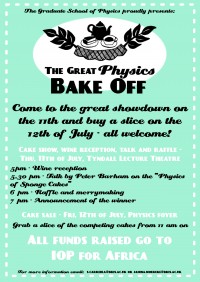By Matin Durrani

Cakes from the Great Physics Bake Off, with the overall winner second bottom on the left. (Courtesy: Chris Hodges)
And so to the physics department at Bristol University last night, which played host to “The Great Physics Bake Off” organized by PhD students Janina Möreke and Sara Carreira. The aims were simple: to showcase the cake-baking talent of the department, have some fun, and at the same time raise money for IOP for Africa – the scheme run by the Institute of Physics, which publishes Physics World, to boost physics education in some of the poorest countries in the world.
With 18 entries from seven research groups, the judging panel, which naturally included Bristol’s famous foodie physicist Peter Barham, must have consumed a fair few calories in picking the winning entries. Ian Griffiths eventually bagged first prize, which was appropriately a Raspberry Pi mini-computer. Researchers from the Micro and Nanostructural Materials Group won the “group award”, while Nicole Killat picked up a prize for the cake with the “most scientific relevance”.
Sadly, I didn’t get to taste any of the goodies myself, which are being sold today to raise money for IOP for Africa. But certainly Nicole’s effort was my pick of the bunch, probably because it took the physics connection way too literally. She’d baked a 3D composite structure – a high-electron-mobility transistor, in fact – consisting of a silicon-carbide substrate underpinning a delicious-looking dark-chocolate cream “nucleation layer” and a separate gallium-nitride layer, all topped with a 2D electron gas (vanilla cream with strawberries) and an aluminium–gallium-nitride layer. The upper surface of the cake featured a silicon-nitride passivation (chocolate cream) and electrical contacts in the form of more vanilla cream. Like I say, the cake took the physics connection to the limit.
Guests were also treated to a light-hearted lecture by Peter Barham on the physics of baking a sponge cake. Doing it right is not, ahem, a piece of cake; cakes are, after all, complex composite materials consisting of fat, sugar, flour, eggs, flavouring and that all-important ingredient – air. As Barham pointed out to the audience while sipping on a glass of red wine, without some good bubbles in your cake, you’d be eating a lump of stodge. And no-one wants that do they?
Barham also had some useful top tips for the kitchen – a cake with too little fat will quickly go stale – and some interesting factoids, such as that the baking soda used in a “standard” 100 gramme cake emits 1.8 litres of carbon dioxide, a third of which will go into the cake itself.
So what’s your secret for the perfect sponge cake? Let us know below.
Update 15 July 2013: Janina tells me the Bristol physicists raised £448.69 for IOP for Africa. Well done them!

Guidelines
Show/hide formatting guidelines
this text was deletedwhere people live in harmony with nature and animals</q>
Some text